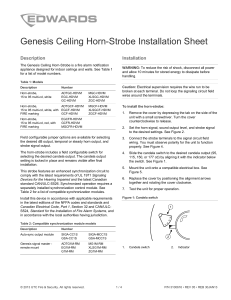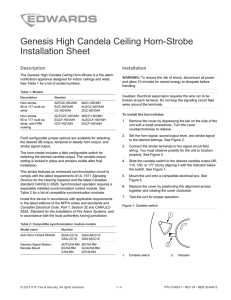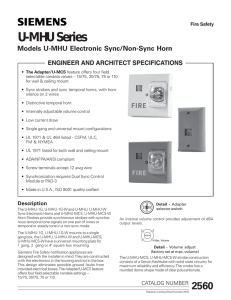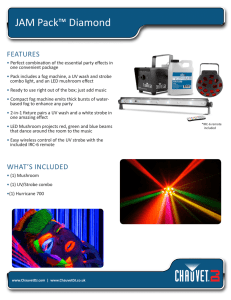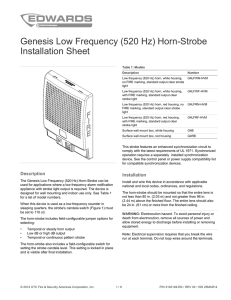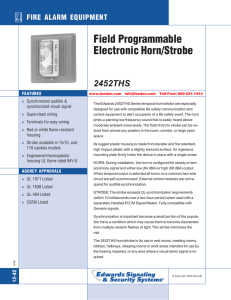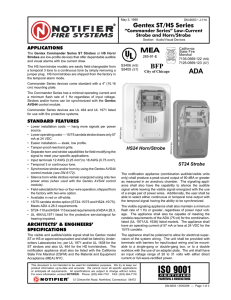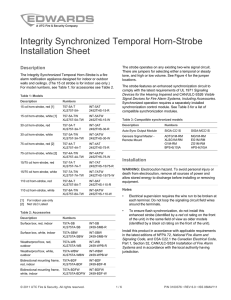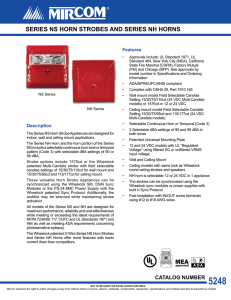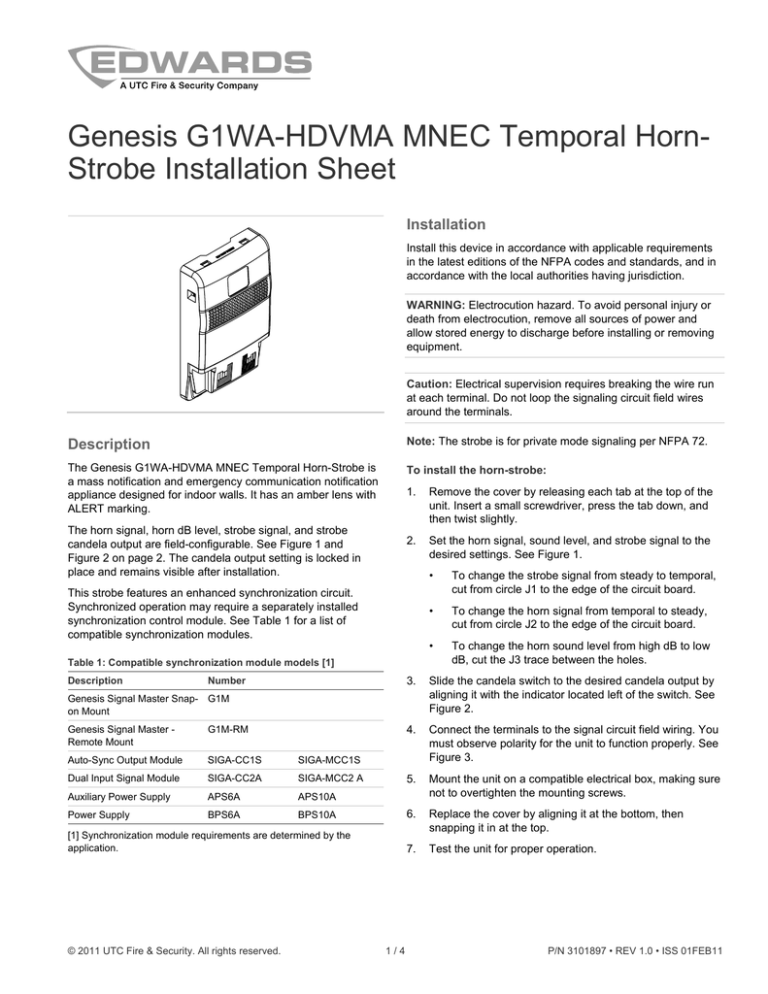
Genesis G1WA-HDVMA MNEC Temporal HornStrobe Installation Sheet
Installation
Install this device in accordance with applicable requirements
in the latest editions of the NFPA codes and standards, and in
accordance with the local authorities having jurisdiction.
WARNING: Electrocution hazard. To avoid personal injury or
death from electrocution, remove all sources of power and
allow stored energy to discharge before installing or removing
equipment.
Caution: Electrical supervision requires breaking the wire run
at each terminal. Do not loop the signaling circuit field wires
around the terminals.
Description
Note: The strobe is for private mode signaling per NFPA 72.
The Genesis G1WA-HDVMA MNEC Temporal Horn-Strobe is
a mass notification and emergency communication notification
appliance designed for indoor walls. It has an amber lens with
ALERT marking.
To install the horn-strobe:
The horn signal, horn dB level, strobe signal, and strobe
candela output are field-configurable. See Figure 1 and
Figure 2 on page 2. The candela output setting is locked in
place and remains visible after installation.
1.
Remove the cover by releasing each tab at the top of the
unit. Insert a small screwdriver, press the tab down, and
then twist slightly.
2.
Set the horn signal, sound level, and strobe signal to the
desired settings. See Figure 1.
This strobe features an enhanced synchronization circuit.
Synchronized operation may require a separately installed
synchronization control module. See Table 1 for a list of
compatible synchronization modules.
Table 1: Compatible synchronization module models [1]
Description
Number
G1M-RM
Auto-Sync Output Module
SIGA-CC1S
SIGA-MCC1S
Dual Input Signal Module
SIGA-CC2A
SIGA-MCC2 A
Auxiliary Power Supply
APS6A
APS10A
Power Supply
BPS6A
BPS10A
[1] Synchronization module requirements are determined by the
application.
© 2011 UTC Fire & Security. All rights reserved.
1/4
To change the strobe signal from steady to temporal,
cut from circle J1 to the edge of the circuit board.
•
To change the horn signal from temporal to steady,
cut from circle J2 to the edge of the circuit board.
•
To change the horn sound level from high dB to low
dB, cut the J3 trace between the holes.
3.
Slide the candela switch to the desired candela output by
aligning it with the indicator located left of the switch. See
Figure 2.
4.
Connect the terminals to the signal circuit field wiring. You
must observe polarity for the unit to function properly. See
Figure 3.
5.
Mount the unit on a compatible electrical box, making sure
not to overtighten the mounting screws.
6.
Replace the cover by aligning it at the bottom, then
snapping it in at the top.
7.
Test the unit for proper operation.
Genesis Signal Master Snap- G1M
on Mount
Genesis Signal Master Remote Mount
•
P/N 3101897 • REV 1.0 • ISS 01FEB11
Specifications
Figure 1: Horn and strobe settings
3
2
1
J2 J3
J1
1.
2.
3.
Operating voltage
16 to 33 VDC; 16 to 33 VFWR
Operating horn-strobe
current
See Table 5
Sound level output
See Table 2
Audible directional
characteristics
See Table 3 and Table 4
Light output
Selectable at 13, 26, 65, and 95 cd
Synchronization
Maximum allowed resistance between any
two devices is 20 Ω. Refer to specifications
for the synchronization control module, this
strobe, and the control panel to determine
allowed wire resistance.
J1: Strobe signal (steady or temporal)
J2: Horn signal (steady or temporal)
J3: Horn dB level (high or low)
Figure 2: Candela switch
A
B
C
D
= 95 cd
= 65 cd
= 26 cd
= 13 cd
Default settings
Horn
Strobe
Temporal signal, high dB level
Steady -1 flash per second (fps)
Wire size
12 to 18 AWG (0.75 to 2.50 mm²)
Compatible electrical
boxes
2-1/2 in. (64 mm) deep single-gang box;
4 in. square box × 1-1/2 in. (38 mm) deep or
4 in. octagonal with G1T or trim accessory
and single-gang plastic ring
Operating environment
Temperature
Relative humidity
32 to 120°F (0 to 49°C)
0 to 93% noncondensing
Table 2: UL ratings, sound level output
Figure 3: Wiring diagram
Signal
Low
High
Temporal
76.0
81.4
Steady
80.1
85.5
UL 464: Sound level output at 10 ft. (3.05 m) measured in a
reverberant room at 16 V.
Table 3: Audible directional characteristics (horizontal pattern)
+
1
2
-
1.
2.
From compatible fire alarm control panel
To next appliance, EOL, or return to source
Note: Polarity is shown in the alarm condition.
Angle (°) [1]
Output (dB) [2]
0
0
+18
−3
+42
−6
-50
−3
-75
−6
[1] Angles are measured from a perpendicular axis; positive angles to
the right.
[2] Peak output at 16 VDC, set for steady tone.
Table 4: Audible directional characteristics (vertical pattern)
Maintenance
Angle (°) [1]
Output (dB) [2]
0
0
Caution: To maintain the required agency listings, do not
change factory-applied finishes.
+20
−3
+45
−6
−20
−3
−52
−6
This unit is not serviceable or repairable. Should the unit fail to
operate, contact the supplier for replacement.
Perform a visual inspection and an operational test twice a
year, or as directed by the local authority having jurisdiction.
[1] Angles are measured from a perpendicular axis; positive angles are
up.
[2] Peak output at 16 VDC, set for steady tone.
2/4
P/N 3101897 • REV 1.0 • ISS 01FEB11
Figure 5: Typical vertical light output profile, 95 cd setting
Table 5: Operating current
Voltage
Strobe (cd)
Current (ARMS)
VDC
13
0.129
26
0
335
340
345
350 355
120
5
10
15
20
25
330
0.167
30
325
35
100
320
65
0.281
40
315
45
80
310
95
VFWR
0.337
13
0.176
26
0.230
50
305
55
300
60
60
295
65
290
70
40
285
65
0.397
95
0.443
75
280
80
20
275
VDC = Volts direct current, regulated and filtered
VFWR = Volts full wave rectified
85
270
90
265
95
260
100
255
Operating currents shown above were measured by UL at 16 VDC and
16 VFWR and high dB setting.
105
250
110
245
ARMS = Amperes root mean square
115
240
120
235
125
230
130
225
Figure 4: Typical horizontal light output profile, 95 cd setting
135
220
140
215
145
210
335
340
345
330
350 355
160
0
5
10
15
20
310
305
40
55
1.
2.
60
60
75
280
80
20
Regulatory information
85
270
90
265
95
260
Manufacturer
Edwards, A Division of UTC Fire & Security
Americas Corporation, Inc.
8985 Town Center Parkway, Bradenton, FL
34202, USA
Year of
manufacture
The first two digits of the date code (located on
the product identification label) are the year of
manufacture.
UL rating
Regulated 24 DC and 24 FWR
North American
standards
Meets UL requirements for standards UL 464 and
UL 1638
FCC compliance
This device complies with part 15 of the FCC
Rules. Operation is subject to the following two
conditions: (1) This device may not cause harmful
interference, and (2) this device must accept any
interference received, including interference that
may cause undesired operation.
100
255
105
250
110
245
115
240
120
235
125
230
130
225
135
220
140
215
145
210
150
200
195
190 185
180
175 170
165
160
155
1
1.
2.
Intensity (cd)
Equivalent white light requirement per UL 1971
70
40
205
2
50
65
275
165
1
45
295
290
175 170
35
80
285
190 185
155
30
100
300
195
160
180
120
315
200
25
140
325
320
150
205
Intensity (cd)
Equivalent white light requirement per UL 1971
2
Contact information
For contact information, see www.utcfireandsecurity.com.
P/N 3101897 • REV 1.0 • ISS 01FEB11
3/4
4/4
P/N 3101897 • REV 1.0 • ISS 01FEB11


